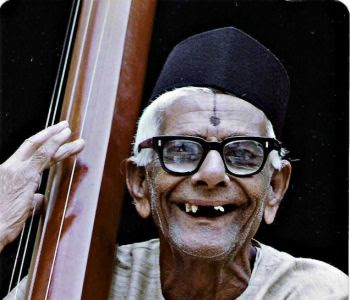
Pandit Ramarao Naik, disciple of Ustad Faiyaz Khan, was an uncompromising exponent of the aggressive Agra gharana. He lived in old-worldly grace, singing and teaching in Bangalore.
Ramarao's father, a self-taught violinist, hailed from Neeralgi in Dharwad district. Sometime in the 1920s, he moved to Mysore and became a clerk in the maharaja's army. There the young Rama Rao happened to hear Hindustani music, thanks to the tastes of the Rajput, Maratha and Muslim soldiers. He spent long hours listening to gramophone records when other boys his age were mugging up their lessons in school.
Venkaji Rao learnt about his son's love of music, and found a teacher for him in B H Srinivasa Rao. Rama Rao learnt Karnatak music from him, and became a teacher himself. He charged Rs 5 a month. In 1993, when I met him at his house in Bangalore's brahmin-dominated Chamarajpet, he said, "Purandaradasa's songs bring the Lord before your very eyes. Many of his compositions should be sung only in the grand Karnatak ragas."
Theatre beckoned him too. For some time, Ramarao played the role of the thief in Sadarame, produced by the famous Gubbi Drama Company. When the company closed down, Rama Rao arrived in Bangalore looking for a job. He found one as a daily-wage worker at Binny Mills.
Around this time he started learning Hindustani music from Govind Vittal Bhave. Swami Vallabhdas, a prominent disciple of Ustad Faiyaz Khan, visited Mysore in 1930. Ramarao accompanied him on the harmonium, an instrument he had taught himself. Swami Vallabhdas invited him to Baroda to learn under his guru.
Faiyaz Khan was the court musician at Baroda. The master of the Agra gharana was a star attraction everywhere, and had little patience to teach. But he allowed his disciples to sit with him on the concert stage and sing along. Ramarao caught his attention, and was soon accompanying him on the tanpura and the harmonium.
Faiyaz Khan's brother-in-law Ata Hussain Khan and Swami Vallabhdas took Ramarao under their wings and taught him the complex Agra style. He spent 10 years in that city, eating fruits, and the pulses his guru got cooked in a separate kitchen.
Many critics say Ramarao was the most faithful exponent of the aggressive Agra style. In Bangalore he taught several students. Mohan Nadkarni, the well-known music critic, feels he was not known widely in other parts of India as his rituals and fasting did not allow him to travel easily. Ramarao was also caught up in domestic troubles.
Ramarao spoke excellent Kannada and Hindi. He wrote occasionally in Kannada, and composed in Hindi. He had no connection with the market-savvy English-speaking world; he lived in old-worldly grace, chatting, taking joy rides on the pillion of Sumati's TVS Scooty, attending to the concerns of his extended family, singing bhajans at the neighbouring math, and teaching. All his students vouch for his greatness as a teacher, especially his ability to explain abstract musical ideas with clarity and to spark in them a passion for musical exploration.
No comments:
Post a Comment